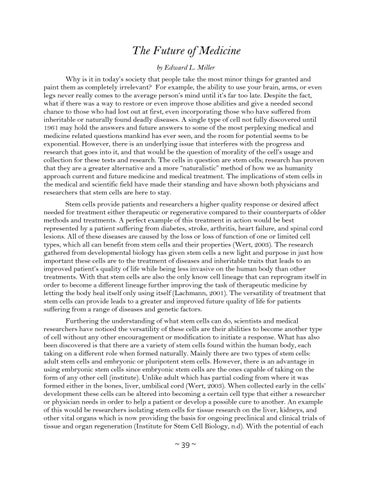The Future of Medicine by Edward L. Miller Why is it in today’s society that people take the most minor things for granted and paint them as completely irrelevant? For example, the ability to use your brain, arms, or even legs never really comes to the average person’s mind until it’s far too late. Despite the fact, what if there was a way to restore or even improve those abilities and give a needed second chance to those who had lost out at first, even incorporating those who have suffered from inheritable or naturally found deadly diseases. A single type of cell not fully discovered until 1961 may hold the answers and future answers to some of the most perplexing medical and medicine related questions mankind has ever seen, and the room for potential seems to be exponential. However, there is an underlying issue that interferes with the progress and research that goes into it, and that would be the question of morality of the cell’s usage and collection for these tests and research. The cells in question are stem cells; research has proven that they are a greater alternative and a more “naturalistic” method of how we as humanity approach current and future medicine and medical treatment. The implications of stem cells in the medical and scientific field have made their standing and have shown both physicians and researchers that stem cells are here to stay. Stem cells provide patients and researchers a higher quality response or desired affect needed for treatment either therapeutic or regenerative compared to their counterparts of older methods and treatments. A perfect example of this treatment in action would be best represented by a patient suffering from diabetes, stroke, arthritis, heart failure, and spinal cord lesions. All of these diseases are caused by the loss or loss of function of one or limited cell types, which all can benefit from stem cells and their properties (Wert, 2003). The research gathered from developmental biology has given stem cells a new light and purpose in just how important these cells are to the treatment of diseases and inheritable traits that leads to an improved patient’s quality of life while being less invasive on the human body than other treatments. With that stem cells are also the only know cell lineage that can reprogram itself in order to become a different lineage further improving the task of therapeutic medicine by letting the body heal itself only using itself (Lachmann, 2001). The versatility of treatment that stem cells can provide leads to a greater and improved future quality of life for patients suffering from a range of diseases and genetic factors. Furthering the understanding of what stem cells can do, scientists and medical researchers have noticed the versatility of these cells are their abilities to become another type of cell without any other encouragement or modification to initiate a response. What has also been discovered is that there are a variety of stem cells found within the human body, each taking on a different role when formed naturally. Mainly there are two types of stem cells: adult stem cells and embryonic or pluripotent stem cells. However, there is an advantage in using embryonic stem cells since embryonic stem cells are the ones capable of taking on the form of any other cell (institute). Unlike adult which has partial coding from where it was formed either in the bones, liver, umbilical cord (Wert, 2003). When collected early in the cells’ development these cells can be altered into becoming a certain cell type that either a researcher or physician needs in order to help a patient or develop a possible cure to another. An example of this would be researchers isolating stem cells for tissue research on the liver, kidneys, and other vital organs which is now providing the basis for ongoing preclinical and clinical trials of tissue and organ regeneration (Institute for Stem Cell Biology, n.d). With the potential of each
~ 39 ~






